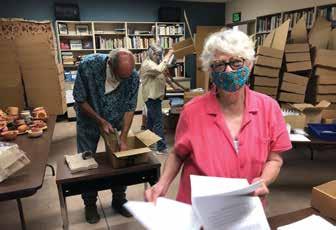
2 minute read
OFFICE OF ARCHAEOLOGICAL STUDIES
Layers in the Learning Providing Experiential Education
Four hundred ceramic pots. Six hundred tiles made from native clay. And one week of at-home archaeological lessons.
That’s what went into the 200 Project Archaeology boxes distributed by the Office of Archaeological Studies to libraries statewide this summer.
The kits, called Making and Breaking Pots, are part of the Department of Cultural Affairs Summer Youth Program. While much of that program’s content is virtual, the archaeology offerings are grounded in physical, experiential learning. “We’re trying to give kids an alternative to screen time,” says Office of Archaeological Studies ethnobotanist Mollie Toll.
Toll helped conceive and assemble the kits with her osteologist colleague, Caitlin Ainsworth, and a group of volunteers who make up the Project Archaeology team. It’s all under the umbrella of the Office of Archaeological Studies award-winning Education Outreach Program,

Dr. Sherill Spaar and her colleagues assemble take-home education kits distributed by the Office of Archaeological Studies. which is supported in part by gifts from private donors to the Museum of New Mexico Foundation.
One of Project Archaeology’s main goals is for kids to be self-guided by the enclosed directions in the kits, though parents also received a page of troubleshooting instructions. Toll emphasizes the importance of children having control over their own lessons. “There’s all kinds of really nice research that shows when kids reflect on their own process in an open-ended way, they do much more learning,” she says. “There are layers after layers in there of critical thinking skills, literacy skills and math skills.”
One activity involves two kinds of dirt and a jar. Students are instructed to add water, investigate the layers that form, and see what conclusions can be drawn. Another lesson directs kids to make an inventory of the vessels in their homes and compare them to the pots and tiles included in the kit.
With an emphasis on rural and tribal libraries, 50 boxes went to libraries in northern New Mexico, while the rest made their way to points south. “We’re banking on those librarians knowing their community,” Toll notes, explaining the importance of hands-on Project Archaeology lessons going to families who are most eager for them. With a laugh, Toll recalls one model student she encountered last spring. “I put a science kit in the front seat of a car,” she says, “and this kid unbuckled his seatbelt and dove into the seat.”








